Lucinda Devlin
The Omega Suites
From 1991-1998 photographer Lucinda Devlin entered two thirds of the prisons in the United States which carry out the death penalty and photographed the unoccupied execution chambers within. The photographs are part of a logical progression of projects exploring the intimacy of the body in relation to procedures, whether medical, judicial or therapeutic, which require varying degrees of passivity from the participants. Although her intention was not to create a polemic on the death penalty, still, the work has often been perceived in this way through the ensuing years.
The Omega Suites, as the resulting work is entitled, has illuminated, through its power as art, an aspect of American society that continues to cause conflicting dialogue, calling into question the basic precepts of what constitutes a civilized society.
The artist has accomplished this without imposing a personal point of view, preferring to allow the individual viewer to come to their own conclusions regarding these spaces and their use.
(Abstract for the “Last Gaze” conference, Nov 19, 20th 2009 at the Braunschweig University of Art)
The Omega Suites, as the resulting work is entitled, has illuminated, through its power as art, an aspect of American society that continues to cause conflicting dialogue, calling into question the basic precepts of what constitutes a civilized society.
The artist has accomplished this without imposing a personal point of view, preferring to allow the individual viewer to come to their own conclusions regarding these spaces and their use.
(Abstract for the “Last Gaze” conference, Nov 19, 20th 2009 at the Braunschweig University of Art)
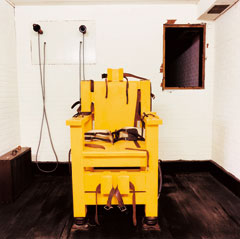
Electric Chair, Holman Unit, Atmore,
Alabama, 1991
Alabama, 1991
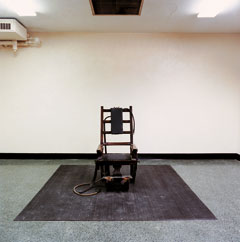
Electric Chair, Greenhaven Correctional
Facility, Greenhaven, New York, 1991
Facility, Greenhaven, New York, 1991
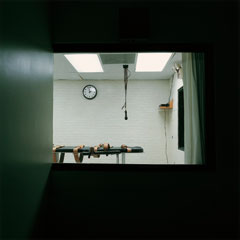
Lethal Injection Chamber from Witness
Room, Parchman State penitentiary,
Parchman, Mississippi, 1998
Room, Parchman State penitentiary,
Parchman, Mississippi, 1998
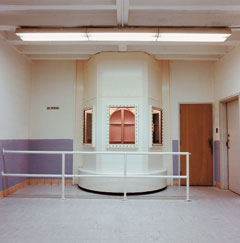
Gas Chamber, Maryland State
Penitentiary, Baltimore, Maryland, 1991
Penitentiary, Baltimore, Maryland, 1991
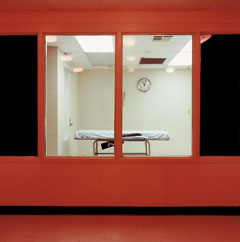
Lethal Injection Chamber from Witness
Room, Cummins Unit, Arkansas, 1991
Room, Cummins Unit, Arkansas, 1991
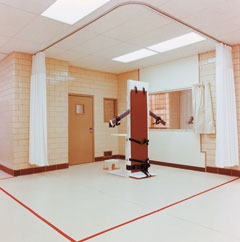
LethalLethal Injection Chamber, Territorial
Correctional Facility, Canon City, Colorado
1991
Correctional Facility, Canon City, Colorado
1991
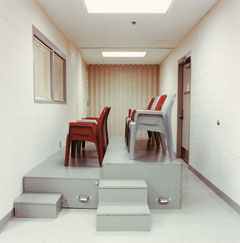
Witness Room, Petosi Correctional Center,
Petosi, Missouri, 1991
Petosi, Missouri, 1991
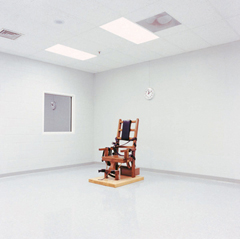
Electric Chair Greensville Correctional
Facility, Jarratt, Virginia, 1991
Facility, Jarratt, Virginia, 1991
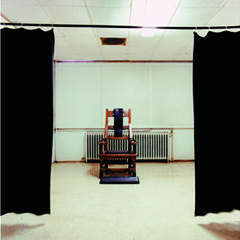
Electric Chair, Indiana State Prison
Michigan City, Indiana
Michigan City, Indiana
I wasn't prepared for this. Looming in front of me was a massive, gray bunker. It looked impenetrable. Guard towers ascended at each end and concertina wire was set atop the wall all the way around. I don't know what I was expecting, but my heart was beating wildly as I was asked to remove my belt and shoes. After being thoroughly searched, my hand was stamped with an invisible substance which glowed under ultraviolet light, and I was escorted through successive barred doors. The guard accompanying me was young and not too tall, but he obviously spent a lot of time with weights. He was taut and not just because of his well muscled body. It was also in his demeanor. In fact, this tension was palpable all around me.
The doors he escorted me through opened and closed automatically at his signal to the door master, who was herself ensconced in a bullet proof booth. Every sound was magnified, echoing off the cement and steel. We walked through a courtyard and headed toward the watch tower at the far end. On our approach, the tower guard dropped a bucket on a rope and my guard removed the keys it contained. As we moved through the hallways and cellblocks, huge five foot square fans sat on the floor to provide relief. No air conditioning here. To the right was a barred lounge with striking murals on the walls which, I was informed, were painted by one of the inmates on the "row"—death row, that is. I was asked to keep my eyes forward because an inmate was taking a shower on the left. No problem. I was trying to avoid the stares leveled at me anyway. On we went deeper into the innermost parts of the prison. The heat and humidity were oppressive, more so considering the environment of maximum security. The guard stopped in front of a door and, fumbling with the set of six inch long keys, finally opened it into a small, very damp room. And there it was, the "Yellow Mama", the electric chair so named because it was painted a bright school bus yellow. It was a room you might be curious enough to visit, but you wouldn't want to die there. But many have and many more, no doubt, will. For this is one of the rooms where society's will is carried out. It is a death chamber. One of 38 in states that have the death penalty.
When I began this photographic project, I had little knowledge of the death penalty in America. But one cannot go in and out of maximum security prisons and view a wide assortment of spaces intended for killing people without becoming curious about the laws, the people charged with carrying out those laws, the living environments, and most importantly, the inmates on death row who are irrevocably affected by this singular punishment.
Each prison is quite different from the next, most of them being maximum security. They range from new, sprawling facilities on hundreds of rural acres with beautiful landscaping and cattle herds for self-sufficiency, to big city penitentiaries with buildings a hundred years old and with the air of a Victorian mad house. Some had enormous numbers of security measures requiring identification and multiple searches at each stop along the way. At other facilities, I was whisked by a Captain or Assistant Warden in an institutional vehicle to some separate part of the grounds where the death house was located.
Unlike any other western nation, the United States stands with countries like Iran, Iraq and China in retaining the death penalty. In the United States there are five legal methods of execution: electric chair, gas chamber, lethal injection, hanging and firing squad, and in a few states, the condemned has a choice between methods.
Studies continue to show that over 70% of Americans favor the death penalty. This figure has steadily risen since the mid 60's when only 42% favored it. In 1972 the Supreme Court, in Furman vs Georgia, ruled that capital punishment sentencing systems then in effect were violations of the 8th Amendment's prohibition of "cruel and unusual punishment". All the states that had death penalty statutes now invalidated by the new ruling, quickly worked to rewrite them. In 1976, in Gregg vs Georgia, the court ruled that statutes that provided for "guided discretion" in imposing the death sentence did not violate the 8th amendment. Soon, hundreds of people were sentenced to death under these new statutes.
Currently, there are over 3000 people under the sentence of death, approximately 30 of whom were juvenile offenders when the death penalty was imposed. Since 1976 until February 1999, 436 executions have taken place. According to Amnesty International, African Americans comprise about 12% of the national population, although they receive 41% of the death sentences. While blacks and whites are victims of homicide in statistically equal numbers, most defendants receiving the death penalty killed white victims. Women account for 2% of death penalty sentences, and 1.5% of people on death row.
Most inmates now spend an average of 10 years on death row waiting for their appeals to run their course. Recent Supreme Court decisions have shortened the appeals process so that the rate of executions has risen. A few win liberty (see the film "The Thin Blue Line") or are commuted to a life sentence. The rest wait and sometimes have several execution dates pronounced, then stayed, before the end comes and they finally take "the walk". States vary widely in their treatment and housing of inmates under the sentence of death. Some, believing the inmate is already suffering the most extreme punishment, are more progressive and house the inmate in the general prison population. Other prison systems continue to segregate and severely limit their lives. Many describe themselves as the "living dead", spending day after day running into year after year in 6X8 foot cells.
Prison officials are very sensitive about the perception of their roles in carrying out a death penalty sentence. State legislatures make the laws, district attorneys decide which cases are going to be tried as capital offenses, judges and juries impose the death sentence, but it is the prison personnel who carry out the penalty. Their lives are affected in a very direct way and they do not treat their role with indifference. Among the many wardens, guards and other administratie personnel I spoke with there was a great deal of ambivalence about the death penalty. Feelings ranged from the Assistant Warden who was against it and didn't know how he was going to cope when it came time to actually execute someone, to those who felt it might be appropriate in selected cases, to the guard who said "gas them all" as far as he was concerned.
As it was described to me at one facility, a few days before a scheduled execution the mood of the prison changes. The entire institution is affected by the magnitude of what is about to happen. There is a high degree of ritualization governing the days and procedures leading up to the event. In his book, "Death Row Chaplain", Byron Eshelman says "Only the ritual of an execution makes it possible to endure. Without it, the condemned could not give the expected measure of cooperation to the etiquette of dying. Without it, we who must preside at their deaths could not face the morning of each new day".
Once an execution date has been set, the condemned is brought to the holding cell adjoining the death chamber and the"death watch" begins. The inmate is observed 24 hours a day to insure he or she will not commit suicide. The condemned is allowed time on the last days for final visits with lawyers and loved ones and to make arrangements for the disposal of his or her belongings. Each state has its own set of lengthy procedures governing these rituals, some more or less elaborate. But ultimately, the condemned walks to the death chamber, usually accompanied by a member of the clergy, a doctor and other members of the execution team, and is strapped down and otherwise prepared—electrodes attached, veins probed and IV's inserted. Then he or she hears the death warrant read aloud, is allowed to make a last statement, and finally is jolted with 2000 volts of electricity, injected with a series of drugs, or gassed with cyanide until dead.
It sounds so clean and simple, this legal killing. But only if you don't focus on the human beings involved. And only if you don't hear the details of their tortured lives and deaths.
Violent crime is outrageous, but can we be sure that the social forces which contribute to shaping behavior have no part in the perpetration of those acts? Do we believe that no violent criminal can be rehabilitated and that killing the killer solves the problem? Do we want revenge and retribution above all else?
When I began photographing death chambers I was no longer sure, as I had been in the 60's an 70's, that I was against the death penalty. So I began reading all the arguments in favor and against, the statistics and the court rulings. What I found was this. There is no evidence showing the death penalty has any deterrent effect. The poor and African American segments of our society are the sole recipients of the death penalty. Only a small percentage of the 20,000 murders which take place each year are punished by death, which makes it a very cruel and unusual punishment indeed.
The weight of judicially sanctioned killing in retribution for capital crimes is on society's shoulders. As members of that society, it is incumbent upon us to understand the ramifications of this ultimate punishment that is being meted out behind closed doors and in our names.
The doors he escorted me through opened and closed automatically at his signal to the door master, who was herself ensconced in a bullet proof booth. Every sound was magnified, echoing off the cement and steel. We walked through a courtyard and headed toward the watch tower at the far end. On our approach, the tower guard dropped a bucket on a rope and my guard removed the keys it contained. As we moved through the hallways and cellblocks, huge five foot square fans sat on the floor to provide relief. No air conditioning here. To the right was a barred lounge with striking murals on the walls which, I was informed, were painted by one of the inmates on the "row"—death row, that is. I was asked to keep my eyes forward because an inmate was taking a shower on the left. No problem. I was trying to avoid the stares leveled at me anyway. On we went deeper into the innermost parts of the prison. The heat and humidity were oppressive, more so considering the environment of maximum security. The guard stopped in front of a door and, fumbling with the set of six inch long keys, finally opened it into a small, very damp room. And there it was, the "Yellow Mama", the electric chair so named because it was painted a bright school bus yellow. It was a room you might be curious enough to visit, but you wouldn't want to die there. But many have and many more, no doubt, will. For this is one of the rooms where society's will is carried out. It is a death chamber. One of 38 in states that have the death penalty.
When I began this photographic project, I had little knowledge of the death penalty in America. But one cannot go in and out of maximum security prisons and view a wide assortment of spaces intended for killing people without becoming curious about the laws, the people charged with carrying out those laws, the living environments, and most importantly, the inmates on death row who are irrevocably affected by this singular punishment.
Each prison is quite different from the next, most of them being maximum security. They range from new, sprawling facilities on hundreds of rural acres with beautiful landscaping and cattle herds for self-sufficiency, to big city penitentiaries with buildings a hundred years old and with the air of a Victorian mad house. Some had enormous numbers of security measures requiring identification and multiple searches at each stop along the way. At other facilities, I was whisked by a Captain or Assistant Warden in an institutional vehicle to some separate part of the grounds where the death house was located.
Unlike any other western nation, the United States stands with countries like Iran, Iraq and China in retaining the death penalty. In the United States there are five legal methods of execution: electric chair, gas chamber, lethal injection, hanging and firing squad, and in a few states, the condemned has a choice between methods.
Studies continue to show that over 70% of Americans favor the death penalty. This figure has steadily risen since the mid 60's when only 42% favored it. In 1972 the Supreme Court, in Furman vs Georgia, ruled that capital punishment sentencing systems then in effect were violations of the 8th Amendment's prohibition of "cruel and unusual punishment". All the states that had death penalty statutes now invalidated by the new ruling, quickly worked to rewrite them. In 1976, in Gregg vs Georgia, the court ruled that statutes that provided for "guided discretion" in imposing the death sentence did not violate the 8th amendment. Soon, hundreds of people were sentenced to death under these new statutes.
Currently, there are over 3000 people under the sentence of death, approximately 30 of whom were juvenile offenders when the death penalty was imposed. Since 1976 until February 1999, 436 executions have taken place. According to Amnesty International, African Americans comprise about 12% of the national population, although they receive 41% of the death sentences. While blacks and whites are victims of homicide in statistically equal numbers, most defendants receiving the death penalty killed white victims. Women account for 2% of death penalty sentences, and 1.5% of people on death row.
Most inmates now spend an average of 10 years on death row waiting for their appeals to run their course. Recent Supreme Court decisions have shortened the appeals process so that the rate of executions has risen. A few win liberty (see the film "The Thin Blue Line") or are commuted to a life sentence. The rest wait and sometimes have several execution dates pronounced, then stayed, before the end comes and they finally take "the walk". States vary widely in their treatment and housing of inmates under the sentence of death. Some, believing the inmate is already suffering the most extreme punishment, are more progressive and house the inmate in the general prison population. Other prison systems continue to segregate and severely limit their lives. Many describe themselves as the "living dead", spending day after day running into year after year in 6X8 foot cells.
Prison officials are very sensitive about the perception of their roles in carrying out a death penalty sentence. State legislatures make the laws, district attorneys decide which cases are going to be tried as capital offenses, judges and juries impose the death sentence, but it is the prison personnel who carry out the penalty. Their lives are affected in a very direct way and they do not treat their role with indifference. Among the many wardens, guards and other administratie personnel I spoke with there was a great deal of ambivalence about the death penalty. Feelings ranged from the Assistant Warden who was against it and didn't know how he was going to cope when it came time to actually execute someone, to those who felt it might be appropriate in selected cases, to the guard who said "gas them all" as far as he was concerned.
As it was described to me at one facility, a few days before a scheduled execution the mood of the prison changes. The entire institution is affected by the magnitude of what is about to happen. There is a high degree of ritualization governing the days and procedures leading up to the event. In his book, "Death Row Chaplain", Byron Eshelman says "Only the ritual of an execution makes it possible to endure. Without it, the condemned could not give the expected measure of cooperation to the etiquette of dying. Without it, we who must preside at their deaths could not face the morning of each new day".
Once an execution date has been set, the condemned is brought to the holding cell adjoining the death chamber and the"death watch" begins. The inmate is observed 24 hours a day to insure he or she will not commit suicide. The condemned is allowed time on the last days for final visits with lawyers and loved ones and to make arrangements for the disposal of his or her belongings. Each state has its own set of lengthy procedures governing these rituals, some more or less elaborate. But ultimately, the condemned walks to the death chamber, usually accompanied by a member of the clergy, a doctor and other members of the execution team, and is strapped down and otherwise prepared—electrodes attached, veins probed and IV's inserted. Then he or she hears the death warrant read aloud, is allowed to make a last statement, and finally is jolted with 2000 volts of electricity, injected with a series of drugs, or gassed with cyanide until dead.
It sounds so clean and simple, this legal killing. But only if you don't focus on the human beings involved. And only if you don't hear the details of their tortured lives and deaths.
Violent crime is outrageous, but can we be sure that the social forces which contribute to shaping behavior have no part in the perpetration of those acts? Do we believe that no violent criminal can be rehabilitated and that killing the killer solves the problem? Do we want revenge and retribution above all else?
When I began photographing death chambers I was no longer sure, as I had been in the 60's an 70's, that I was against the death penalty. So I began reading all the arguments in favor and against, the statistics and the court rulings. What I found was this. There is no evidence showing the death penalty has any deterrent effect. The poor and African American segments of our society are the sole recipients of the death penalty. Only a small percentage of the 20,000 murders which take place each year are punished by death, which makes it a very cruel and unusual punishment indeed.
The weight of judicially sanctioned killing in retribution for capital crimes is on society's shoulders. As members of that society, it is incumbent upon us to understand the ramifications of this ultimate punishment that is being meted out behind closed doors and in our names.
